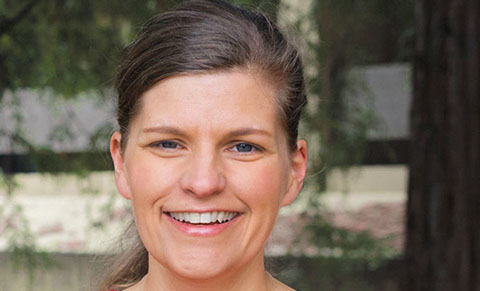Off You Go: A Routine for Culturally Responsive Math

A visually rich routine for teachers leverages a child’s background and helps students build bridges between school math and culture, according to an article co-authored by Northwestern University professor Jen Munson.
Munson’s research-based routine, called Off You Go, uses a classroom or school scavenger hunt format to connect math ideas with the students’ lives. Children are shown an image of a familiar concept, such as a circle, the number 10, or a pattern. After hunting for other examples–at home, outside, in the classroom, or wherever they are–students document their findings by taking pictures, drawing, making lists, or bringing them in for others to see.
The teacher leads a discussion over what properties something needs to represent the concept. Can a squashed circle still be a circle? If a student brings back an oval, does this count? Why or why not? The conversations help students define the properties or characteristics of a concept and move beyond the ways they are typically represented.
“Culturally responsive teaching is often seen as separate from the development of mathematical practices, but in Off You Go they are inherently intertwined,” Munson wrote in the article, “Cultural Responsiveness and Mathematical Practices,” published in the journal Mathematics Teacher: Learning & Teaching PK-12. “Indeed, students’ cultural assets are the very mechanism for developing conceptual precision and driving argumentation.”
Munson, assistant professor of learning sciences in the School of Education and Social Policy, coauthored the article with Geetha Lakshminarayanan and Thomas Rodney. She directs Multiplicity Lab, which helps elementary school teachers provide rich math experiences to their students using tools like Off You Go.
The routines are flexible; they can be used in ten minutes, online or in the classroom. Parents can also implement the methods to enrich their children’s math experience. Munson has given the images to her third grader to annotate, mark up and point out the different things that they see.
The important thing is to “inspire a conversation about the concept and to have the child bring something back to you,” she stressed. “You don't have to have the mathematical expertise to just to sit in a position of wonder with your child.”
When students bring themselves to the discussion, teachers get a more authentic look at what students are thinking and how they reason about concepts,” Munson wrote. “Teachers can then respond both to a diverse set of mathematical representations and to students’ cultural assets, building on each and bridging school mathematics with the more complex and hidden mathematical terrain we each encounter in our lives.”
Students, in turn, are empowered to discuss, debate and question, since there is no answer key.
“Whether prekindergarten students are considering the many ways to represent the number 3 or high school students are pondering the nature of linear relationships, Off You Go can serve as a vessel for seeing and responding to students’ ideas while sharpening them,” the authors wrote.
Munson is a former math coach and elementary and middle school teacher, having worked in school across the US. She studies how interactions both in and outside the classroom support student and teacher learning.
In addition to co-authoring the Mindset Mathematics curriculum series, she has written In the Moment: Conferring in the Elementary Math Classroom, a professional text for teachers which is also available as an audio book. Her new book, The Collaborative Math Classroom: Launching a Student-Centered Mathematical Community, will be published by Heinemann in February.
Lakshminarayanan, is a teacher educator at the Stanford University Graduate School of Education, and Rodney teaches tenth grade math and software engineering at ATech High School in Brooklyn, New York.